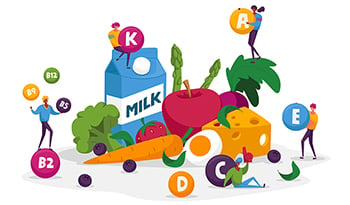Vitamin C for Kids: Is Your Child Getting Enough?
DISCLAIMER:This blog does not intend to provide diagnosis...
- In this article:
- How Do I Know if My Child Is Getting Enough Vitamins?
- Can My Child Overdose on Vitamins?
- What Are the Recommendations for Vitamin C?
- Why Is Vitamin C Important?
- Can Vitamin C Really Help Fight Colds?
- Are There Natural Sources of Vitamin C?
- What Happens if My Child Isn’t Getting Enough Vitamin C?
- What Are the Symptoms of Vitamin C Deficiency?
- Is My Child at Increased Risk of Vitamin C Deficiency?
- What Should I Look for When Choosing a Vitamin C Supplement?
- Key Takeaways

When practicing as a board-certified pediatrician, I often see patients and parents for well-child checkups. During these visits, we discuss diet and nutritional needs. Vitamin requirements and the need for supplementation is a topic that I’m often asked about at these appointments.
Parents typically ask if their children should receive additional supplementation outside of their regular diet. It is definitely an important topic and a key conversation to have with your pediatrician at every visit. So, let’s dive in on the details.
How Do I Know if My Child Is Getting Enough Vitamins?
The American Academy of Pediatrics recommends that children eating a well-balanced diet do not supplement above the recommended dietary allowances. Dietary allowances differ for each vitamin and nutrient and the recommended dietary allowances also vary by age. Keep these points in mind when discussing supplementation with your pediatrician.
Can My Child Overdose on Vitamins?
This is a less common question, but an important one! Large doses of vitamins like A or D can lead to harmful symptoms, so it is important to discuss vitamins with your pediatrician before providing them to your child.
If for some reason your child did take a megadose of vitamin C, he or she would likely experience mild symptoms, such as gastrointestinal upset. Because vitamin C is water-soluble, the excess would be excreted without causing toxicities seen with accidental megadoses of other vitamins.
What Are the Recommendations for Vitamin C?
The recommended daily allowance of vitamin C ranges from 15-45 mg for ages 1-13 and from 65-75 mg for ages 14-18. The recommended amounts differ slightly within those age ranges, so definitely discuss the details and the correct dosage for your child’s particular age with your pediatrician. In general, vitamin C requirements are higher during infections or inflammatory states, or during pregnancy and lactation in adult women.
Tolerable upper intake levels differ from the recommended daily allowances and are typically higher per day for different age groups. Higher doses may be used to treat vitamin C deficiency.
Why Is Vitamin C Important?
Vitamin C is also known as ascorbic acid and it plays an important role in immune system health. It strengthens muscles and skin and it promotes wound and bone healing. Vitamin C also aids in the absorption of iron, another important mineral in the body. Iron carries oxygen throughout the body so that cells can produce energy. When iron levels are low, children may feel tired and/or weak.
Vitamin C is also important for the production of collagen, a protein that helps children form healthy ligaments and tendons and bones and teeth. Collagen is important for skin health, too.
Can Vitamin C Really Help Fight Colds?
Many researchers mention that there may be an association between vitamin C intake and increased immune system function, which can help the body fight infections or cold symptoms. The evidence isn’t definite, though, and there are no clear guidelines that have been created by physicians or by the American Academy of Pediatrics when it comes to increasing vitamin C intake during times of illness.
For the prevention of colds and flu, some recommend at least 200 mg daily of vitamin C; studies have shown a 14% reduction in colds in kids taking this amount. Many children will take in 200 mg with diet alone, so supplementation may not be necessary. However, if kids aren’t feeling well, they tend to eat and drink less, so supplementation should be considered in these situations.
Are There Natural Sources of Vitamin C?
Yes! Since your body does not produce or store vitamin C, it is important to incorporate foods into your diet that contain it. Many foods contain vitamin C, particularly fruits and vegetables. For instance, vitamin C is found in citrus fruits, such as oranges and pineapples as well as melon, strawberries, and tomatoes. You can also find vitamin C in vegetables, including sweet potatoes, spinach, green tomatoes, yellow peppers, and broccoli. Since light and heat can decrease levels, fresh and uncooked fruits and veggies contain higher total levels of vitamin C.
Again, eating a well-balanced diet that includes fruits and vegetables is important. Nonetheless, it is understandable and expected that some children will be very picky eaters and not always eat the amount of fruit and veggies that we’d like them to consume! Making fruit and veggie smoothies or freezing fresh fruit into ice pops are two ways that you might be able to sneak these food groups into your child’s diet.
What Happens if My Child Isn’t Getting Enough Vitamin C?
Chronic vitamin C deficiency leads to a condition known as scurvy. It is relatively rare since most children achieve normal levels of vitamin C through their diets. Some medical conditions can reduce the amount of vitamin C that is absorbed by the body or lead to an increased need for vitamin C.
What Are the Symptoms of Vitamin C Deficiency?
Initial symptoms of vitamin C deficiency may include irritability, loss of appetite and bruising. Gum bleeding is another manifestation of vitamin C deficiency. Children may develop swelling of their joints or aches and pains. Additionally, since vitamin C aids in iron absorption, iron deficiency is commonly seen in combination with inadequate levels of vitamin C.
Treatment for a vitamin C deficiency is increasing intake and your pediatrician can work with you to ensure that your child’s levels of vitamin C rise appropriately.
Is My Child at Increased Risk of Vitamin C Deficiency?
Children with intestinal disorders or some forms of cancer may be at increased risk of vitamin C deficiency. Chronic hemodialysis for patients with renal disease or strict ketogenic diets for patients with refractory seizures may also lead to low vitamin C concentrations. Tobacco smoking and exposure to nicotine increases the vitamin C requirement up to 40%, which is important to keep in mind, especially if your children are exposed to secondhand smoke.
What Should I Look for When Choosing a Vitamin C Supplement?
When considering supplementation, it is important to consider additional ingredients that may be included and unwanted. For example, dyes and artificial coloring or sweeteners are unnecessary and can be avoided when selecting a vitamin C supplement. Look for products that are free of artificial ingredients or fillers. Several vitamin C products are available that are gluten-free, non-genetically modified organisms and gelatin-free.
Flavor is another important consideration when choosing a vitamin supplement for kids. Most children are amenable to fruit or citrus flavors, both of which many vitamin C supplements are available in.
When purchasing a supplement, consider if your child prefers a chewable tablet or a gummy. Vitamin C is also available in liquid formulations if your child cannot yet chew or swallow a gummy or tablet. Vegetarian vitamin C supplements are also available in case an older child has opted for a vegetarian diet.
Look for supplements that are produced in a setting that complies with good manufacturing practices. This system ensures that products are consistently produced and controlled according to quality standards. For children with peanut or nut allergies, be sure to look for vitamin C that is free of both of these ingredients and produced in a nut-free facility.
Key Takeaways
Vitamin C plays an important role in overall health and wellness. The majority of children will achieve recommended daily amounts by eating a varied diet. Some children are at increased risk of vitamin C deficiency and supplementation is key for these kids.
Be sure to give the proper dosage of vitamin C to your child based on his or her age. Look for supplements that are free of artificial ingredients and produced in high-quality facilities.
Always remember to discuss diet and nutrition with your pediatrician!

 By Dr. Cherilyn Cecchini, M.D.
By Dr. Cherilyn Cecchini, M.D.


